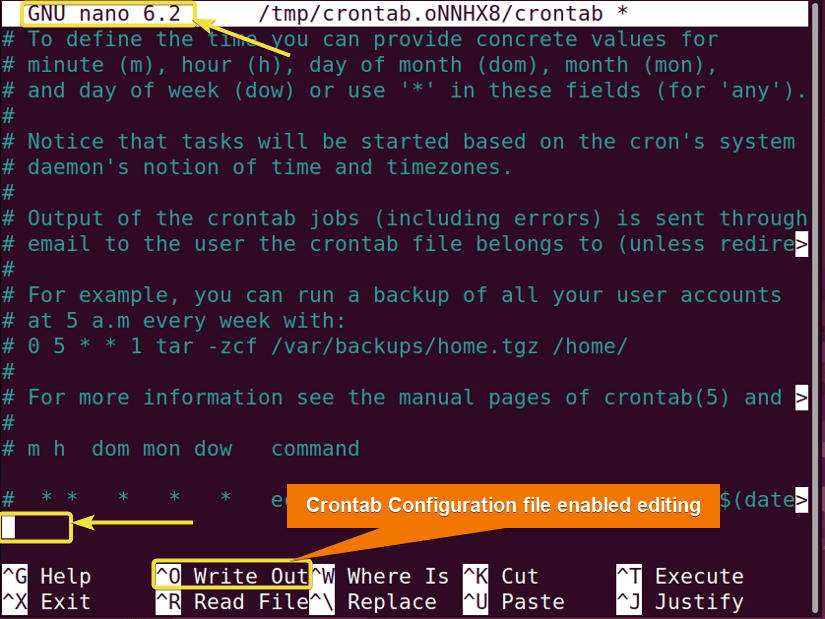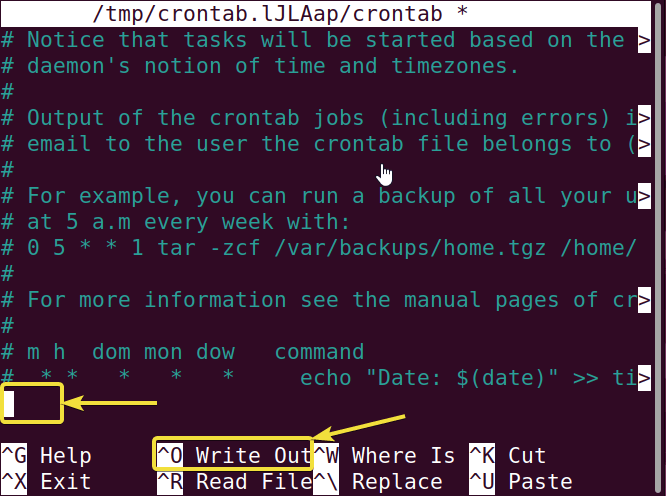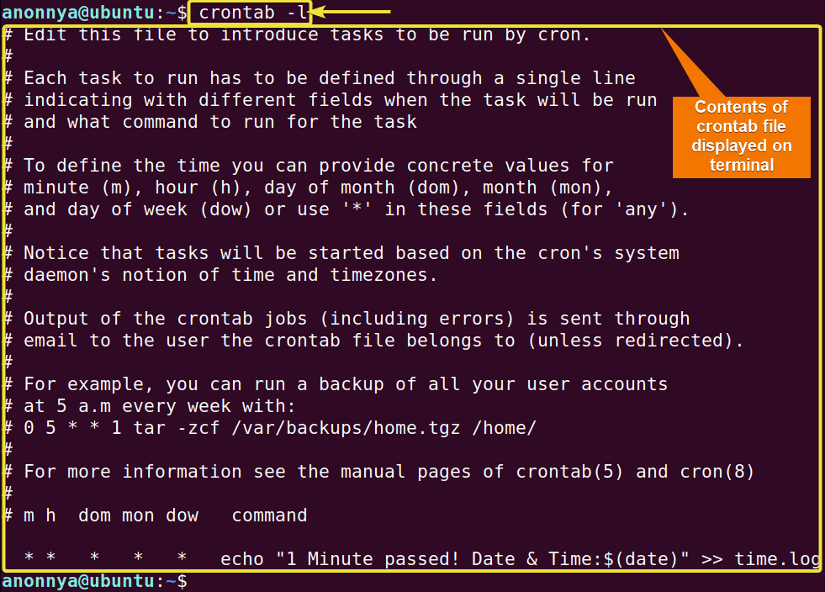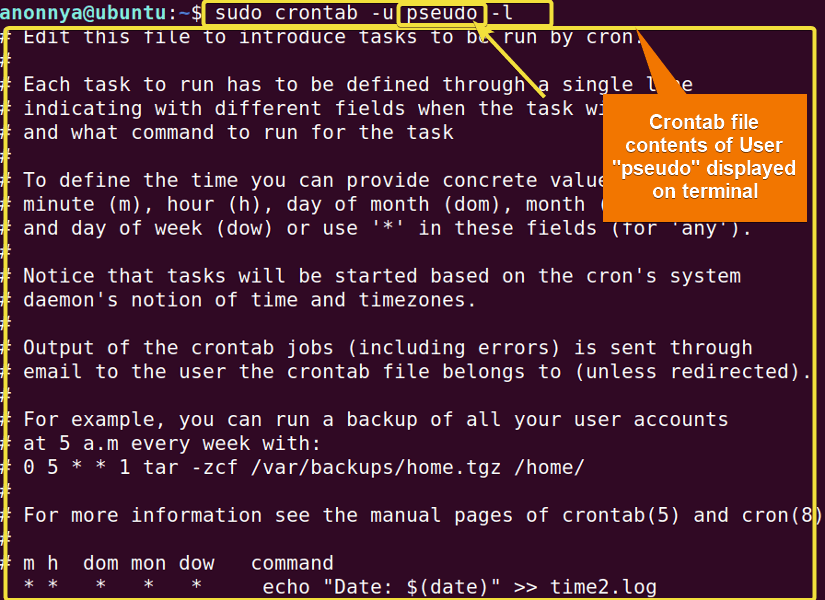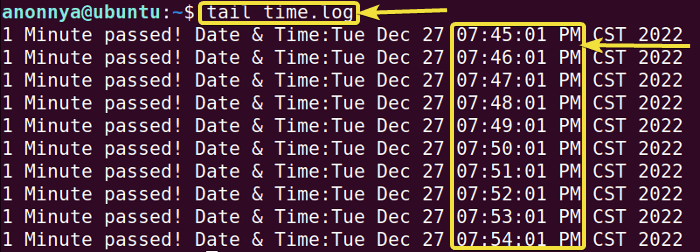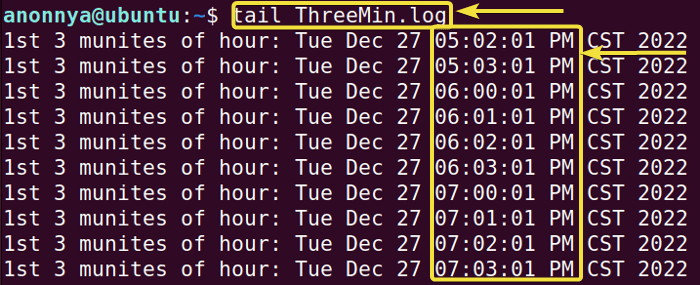FUNDAMENTALS A Complete Guide for Beginners

The crontab command in Linux is used for scheduling tasks at regular intervals. You can add your desired commands/scripts to crontab files by creating an editing session. The listed jobs in the crontab files are run by the cron daemon at predefined times.
A. Description
The crontab command in Linux is the abbreviation for “Cron Table”. It is a program that drives the cron daemon in Linux-like OS. Each user can have their individual crontab files. You can edit these files to schedule tasks in your system. crontab maintains the crontab files for each user. In order to schedule processes using the crontab command in Linux you must be listed in the /etc/cron.allow file. If this file does not exist and another file /etc/cron.deny exists, then must not be listed in this file.
B. Syntax
The syntax of the crontab command in Linux has multiple combinations. You can specify a user’s name while accessing their crontab files. Below I am giving the detailed syntax for the crontab command in Linux.
crontab [ -u user ] filecrontab [ -u user ] [ Option ]C. Options
The crontab command in Linux comes with several options. Here, I am listing the options with explanations for your use. You can also look at the man page to explore further.
man crontabUseful Options
- -u ( Specify the user name whose crontab file is accessed )
- -e ( Edit current crontab using specified editor )
- -l ( Display/List current crontab on the standard output )
- -r ( Remove current crontab )
- -i ( Ask before removing crontab using -r )
NB: The options in Linux CLI (Command Line Interface) are all case-sensitive, So be cautious while using them.
The “crontab” Entries in Linux
Using the crontab command in Linux you can insert commands/scripts in crontab files. These commands will execute at your given time. To achieve this, you will need to follow a certain syntax and use special operators or keywords while creating entries in the file.
A. The syntax for “crontab” Jobs
The syntax given below is a basic format for inserting a job into a crontab file. The first five values indicate when and how often a job/command will execute. These values are separated by a space presenting each individual value.
a b c d e command
B. Operators for “crontab” Jobs
The crontab command in Linux offers the following operators to set a specific time for cron jobs. You can use these operators separately or along with determined values. Following are the operators you can use while assigning cron jobs.
- Asterisk [ 🞸 ], ( Denotes all possible values i.e. 🞸 in the minute field indicates 0,1, 2…59 minutes )
- Comma [ , ] ( Specifies a list i.e. 1, 3, 5, … formate denotes exactly listed values )
- Hyphen [ – ] ( Specifies a range i.e. range 0 – 3 formate denotes values 0, 1, 2 and 3)
- Separator [ / ] ( Skips number of values given after / i.e. */2 in the hour filed will run a task past every 2nd hour )
C. Special Keywords for “crontab” Jobs
You can use a number of special keywords while scheduling jobs using the crontab command in Linux. Most of these keywords have equivalent fields in the crontab job syntax. Some of the keywords and their description are given below.
| Keywords | Equivalent Fields | Description/ Meaning |
|---|---|---|
| @hourly | 0 * * * * | Executes scheduled task at 0 minutes of every hour |
| @daily/@midnight | 0 0 * * * | Executes scheduled tasks at 00:00 of every day |
| @weekly | 0 0 * * 0 | Executes scheduled tasks at 00:00 of every Sunday |
| @monthly | 0 0 1 * * | Executes scheduled task at 00:00 on 1st day of every month |
| @yearly | 0 0 1 1 * | Executes scheduled task every year at 00:00 on 1st day of January |
| @reboot | N/A | Executes scheduled tasks at the system startup |
Practical Examples of the “crontab” Command in Linux
With the crontab command in Linux, you will be able to set/ remove commands to execute at a certain time. You will also be able to explore other users’ crontab files. In this section, I will illustrate some of the most common uses of the crontab command in Linux.
Example 1: Editing Crontab Files Using the “crontab” Command in Linux
You will be able to edit the crontab files of your system using the crontab command in Linux with the option -e. In this example, I will open my crontab file in editing mode using the nano text editor. To do so you can follow the given steps.
Steps to Follow >
➊ At first open the Ubuntu Terminal.
➋ Type the following command in the command prompt:
crontab -e➌ Now, press the ENTER button.
Output >
You can see in the following image, the crontab configuration file has been opened in the nano text editor using the mentioned command. The command has given me permission to write on the crontab file.
Example 2: Editing Crontab Files of Specified User Using the “crontab” Command in Linux
You can edit the crontab files of other users using the crontab command in Linux with the combined options -u and -e. But to do so you will need to run commands as the superuser using the sudo command. In this example, I will open the crontab file of a user named “pseudo”. I will choose the nano as my text editor. To do so you can follow the given steps.
Steps to Follow >
➊ At first open the Ubuntu Terminal.
➋ Type the following command in the command prompt:
sudo crontab -u pseudo -e➌ Press the ENTER button.
➍ Enter your password.
➎ Now, press 1 to choose nano as the editor
➏ Now, Press the ENTER button.
Output >
In the first image, you can see that I ran the command as the supersuer and selected the nano for the editor.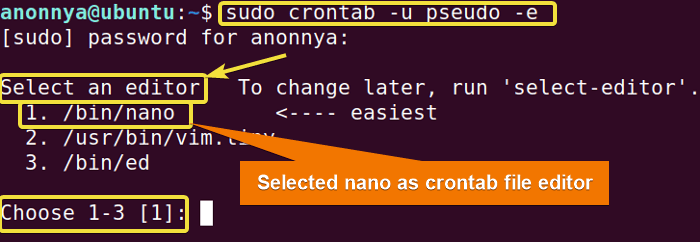
Similar Readings
- The “man” Command in Linux [6 Practical Examples]
- The “history” Command in Linux [6 Practical Examples]
- The “cal” Command in Linux [7 Practical Examples]
- The “bc” Command in Linux [10+ Practical Examples]
Example 3: Viewing Crontab Entries Using the “crontab” Command in Linux
Using the crontab command in Linux with the option -l you can display the contents of your crontab file on the Terminal. In this example, I will demonstrate opening my crontab file on Terminal. To do so you can follow the given steps.
Steps to Follow >
➊ At first open the Ubuntu Terminal.
➋ Type the following command in the command prompt:
crontab -l➌ Now, press the ENTER button.
Output >
You can see in the following image, the contents of my crontab configuration file are being displayed on the Terminal.
Example 4: Viewing Crontab Entries of Specified User Using the “crontab” Command in Linux
Using the crontab command in Linux with the options -u and -l you can display the crontab file contents of a specific user on the Terminal. But to do so you will need to run commands as the superuser typing the sudo command. In this example, I will display the crontab file contents of user “pseudo” on Terminal. To do so you can follow the given steps.
Steps to Follow >
➊ At first open the Ubuntu Terminal.
➋ Type the following command in the command prompt:
sudo crontab -u pseudo -l➌ Press the ENTER button.
➍ Enter your password.
➎ Now, Press the ENTER button.
Output >
In the image below, you can see that the crontab configuration file contents of user “pseudo” are being displayed on the Terminal.
Example 5: Removing Crontab Tasks Using the “crontab” Command in Linux
You can remove your crontab from the command line using the crontab command in Linux. You will need to type the option -r along with the crontab command. In this example, I will remove my crontab file. To do so you can follow the steps below.
Steps to Follow >
➊ At first open the Ubuntu Terminal.
➋ Type the following command in the command prompt:
crontab -r➌ Press the ENTER button.
Output >
In this image, you can see that my crontab configuration file has been deleted. It showed the following message when I tried to display my crontab file using the -l option.
Example 6: Removing Crontab Tasks of Specified User Using the “crontab” Command in Linux
You can remove your crontab file of other users from the command line using the crontab command in Linux. For this, you will need to type the option -r along with the sudo command. In this example, I will remove the crontab file of user “pseudo”. To do so you can follow the steps below.
Steps to Follow >
➊ At first open the Ubuntu Terminal.
➋ Type the following command in the command prompt:
sudo crontab -u pseudo -r➌ Press the ENTER button.
➍ Enter your password.
➎ Now, Press the ENTER button.
Output >
In this image, you can see that the crontab configuration file of “pseudo” has been deleted. It showed the following message when I tried to display the contents of that crontab file using the -l option.
Example 7: Display Confirmation Message Before Removing Crontab Tasks Using the “crontab” Command in Linux
The crontab command in Linux provides an option to display confirmation messages while removing crontab files. You will need to combine the options -i and -r along with the crontab command. In this example, before deleting my crontab file I will show a confirmation message. To do so you can follow the steps below.
Steps to Follow >
➊ At first open the Ubuntu Terminal.
➋ Type the following command in the command prompt:
crontab -i -r➌ Press the ENTER button.
➍ Now, press the y key.
Output >
In this image, you can see that the system is asking for confirmation before deleting my crontab file. I had to enter y to remove the file.
Similar Readings
- The “cron” Command in Linux [3 Practical Examples]
- The “date” Command in Linux [8+ Practical Examples]
- The “ncal” Command in Linux [8 Practical Examples]
Example 8: Scheduling a Job for Every Minute Using the “crontab” Command in Linux
You can schedule a task to execute at regular intervals using the crontab command in Linux. For this, you will need to edit the crontab file using the -e option. In this example, I will schedule a command to run every minute on my machine. You may do so by following the given process.
Steps to Follow >
➊ At first open the Ubuntu Terminal
➋ Type the following command in the command prompt:
crontab -e➌ Press the ENTER button.
➍ Type the following command at the bottom of the crontab configuration file opened in your text editor:
* * * * * echo "1 Minute passed! Date & Time: $(date)" >> time.log➎ Press the CTRL+S keys to save changes.
➏ Now, Press the CTRL+X exit the editor.
Output >
In the image below, you can see that using the nano editor I entered my desired command at the end of the crontab file. I applied the Asterisk ( 🞸) operator to indicate every minute.
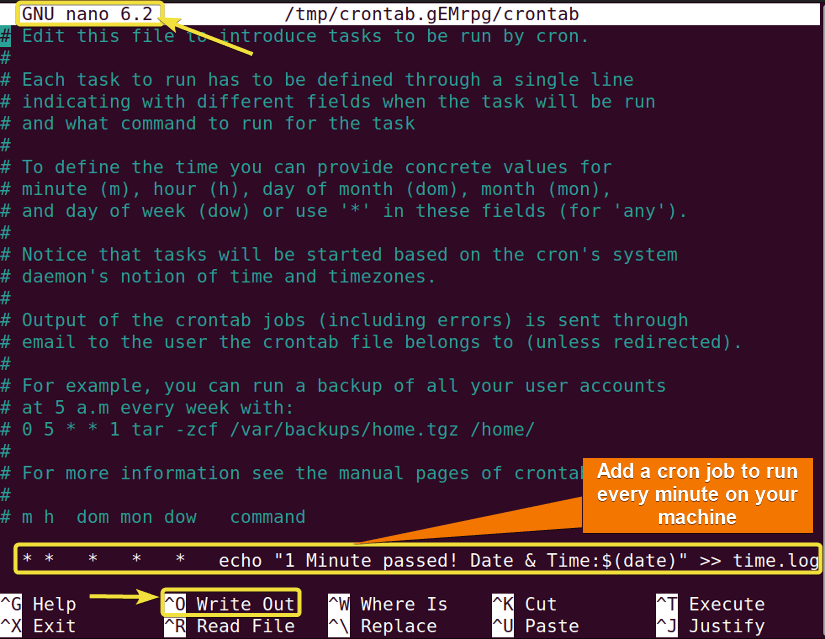
Example 9: Scheduling a Task for a Certain Time Period Using the “crontab” Command in Linux
You can schedule a task to execute at a certain period using the crontab command in Linux. For this, you will need to edit the crontab file using the -e option. In this example, I will schedule a command to run on the first 3 minutes excluding the 0th minute of every hour. You may do so by following the given process.
Steps to Follow >
➊ At first open the Ubuntu Terminal
➋ Type the following command in the command prompt:
crontab -e➌ Press the ENTER button.
➍ Type the following command at the bottom of the crontab configuration file opened in your text editor:
0-3 * * * * echo "1st 3 minutes of hour: $(date)" >> ThreeMin.log➎ Press the CTRL+S keys to save changes.
➏ Now, Press the CTRL+X exit the editor.
Output >
In the image below, you can see that using the nano editor I entered my desired command at the end of the crontab file. I applied the Hyphen ( – ) operator to indicate the first 3 minutes and the Asterisk ( 🞸) operator to indicate every hour.
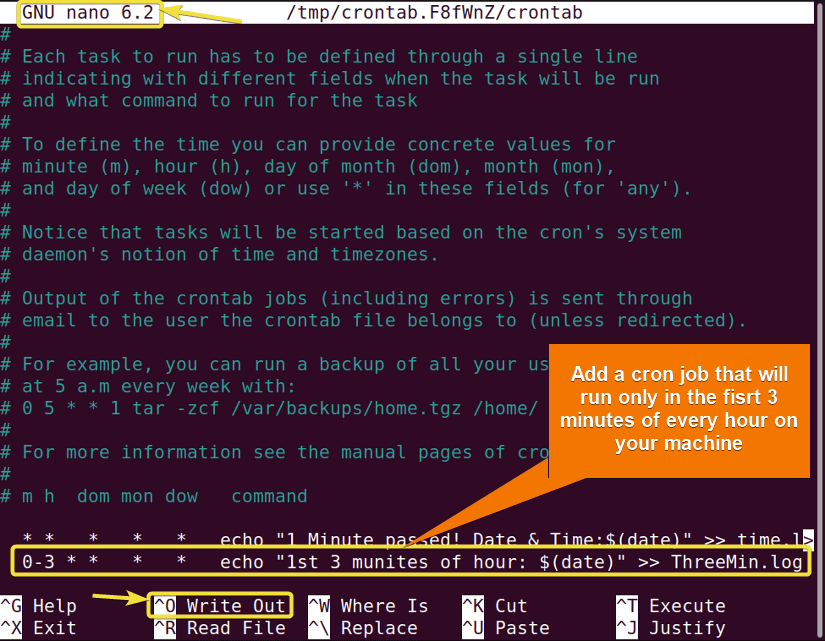
Example 10: Running a Task After Each System Startup/Reboot Using the “crontab” Command in Linux
You can schedule a task to execute at each system startup using the crontab command in Linux. You will need to edit the crontab file using the -e option and use the “@reboot” string before your desired command. In this example, I will schedule a command to run on each system reboot. To do so you can follow the steps below.
Steps to Follow >
➊ At first open the Ubuntu Terminal
➋ Type the following command in the command prompt:
crontab -e➌ Press the ENTER button.
➍ Type the following command at the bottom of the crontab configuration file opened in your text editor:
@reboot echo "1 line at each reboot. Date: $(date)" >> eachReboot.txt➎ Press the CTRL+S keys to save changes.
➏ Now, Press the CTRL+X exit the editor.
Output >
In the image below, you can see that using the nano editor I entered the above-mentioned command at the end of the crontab file. To view the output of the task, I redirected it to the “eachReboot.txt” file using the append (>>) operator.
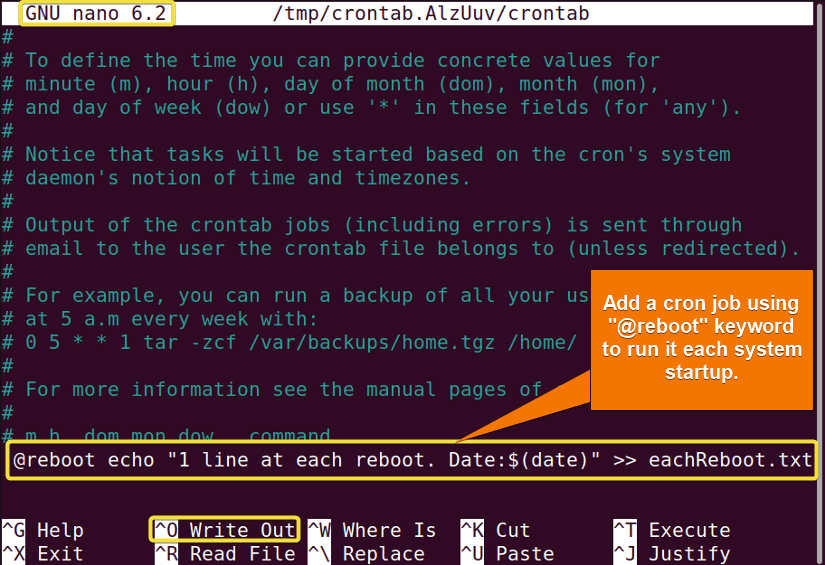
Conclusion
In this article, I have tried to illustrate the basics of the crontab command in Linux. Scheduling tasks for users is considered to be crontab’s main purpose. You will find Job scheduling as well as other examples of crontab in this writing. I hope these practical examples will help you through your journey with the command line and make you a power user of Linux.
Similar Readings
- The “neofetch” Command in Linux [12+ Practical Examples]
- The “tree” Command in Linux [14 Practical Examples]
- The “whatis” Command in Linux [12 Practical Examples]
- The “whereis” Command in Linux [10 Practical Examples]
- The “which” Command in Linux [3 Practical Examples]
- The “at” Command in Linux [7 Practical Examples]
- The “tee” Command in Linux [4 Practical Examples]

